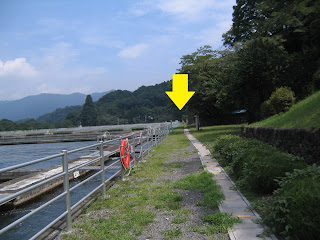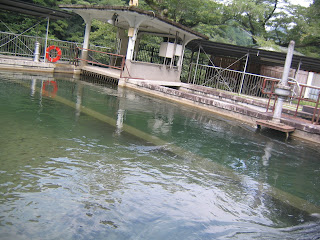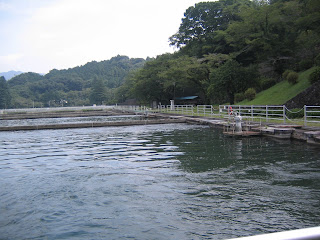Being more exact, the first
modern waterworks of Japan withdrew water from the confluence of Sagami 相模川 and
Doshi Rivers 道志川, approx.
ASL 200m in about 2.5K southwest from the peak of Mt. Takao 高尾山 (ASL 599.3m). In 1887, the system became
operational and pumped up 5720m3 H2O per day for 70
thousand people in Yokohama. The water was then sent via the closed aqueduct to
the first modern Japanese water purification plant in Nogeyama 野毛山, ASL 50m. Nogeyama, where we now have a zoo, is
a small hill situated right behind the downtown of Yokohama named Kan’nai (関内 meaning “within
the gate,” aka “a ghetto,” ASL 3m). The place was started during Tokugawa Shogunate
period 江戸時代 as the “foreigners-only area.” By 1887 Japanese
nationals were allowed to live there freely and to engage in international
business. So, in terms of local politics, economic policy and diplomacy of the
late 19th century, the location of the “water purification plant of
the most advanced technology for the nation” was fitting.
 |
| In the
northwestern part of Yokohama, there runs the “Waterworks Road 水道みち” which is now a pedestrian way over the underground aqueduct coming from the north of the Prefecture. If you find an old-looking brass post, often with a head of lion, sprouting from the road in Yokohama, it’s a sign you are on or near the aqueduct. They were imported and situated there during the late 19th century to make Japan “presentable” for Europeans. |
 |
| And I
found it very interesting the first pricing of water from Yokohama’s waterworks. Foreigners paid more than 10 times for one contract. Er, well, those days, ordinary Japanese lived in attached houses at best and used communal water faucet so that landlords collected tiny water fee from lots of tenants. In contrast, foreigners lived in detached mansions often surrounded by a large private garden with lots of imported water-needy roses. Progressive pricing made sense, huh? The data is shown in Yokohama Waterworks Commemoration Hall 横浜水道記念館. |
Though, the population of
Yokohama kept growing. 5720m3 became quickly not-enough. In 1897, the
city moved the water intake facility 3km upstream of Doshi River, and continued
expanding the water network. When in 1915 the construction of Nishiya Water
Purification Plant 西谷浄水場 was completed, the system was expecting to
supply water for 800 thousand residents. In less than 20 years, the size of
Yokohama literally exploded for more than 10 folds, and Doshi River alone carried
the task to let them watered. After 1915 Yokohama experienced the 1923 GreatKanto Earthquake (関東大震災; Yokohama
was nearer to the epicenter than Tokyo) and the 1945 carpet bombing by the US (横浜大空襲; do you know the US used 320 bombers for one
night over Tokyo, in contrast to 517 bombers for 1 hour over Yokohama?).
Yokohama’s population reached 1 million in 1942. Whatever happened, until 1947
when Sagami Dam became operational, Doshi River was the only water source for
the city of Yokohama. Even today, the water intake from Doshi River is about 9%
of Yokohama’s tap water. In addition, the water from Doshi River is now
partially diverted to 2 underground aqueducts connected with Lake Miyagase
whose water also comes to Yokohama. The abundance of Doshi River is amazing.
Not only of its volume, we have to know the quality. For more than a century,
people talk about Yokohama’s waterworks, “whose water is never rotten for ships
to navigate to Europe via the equator.” Recalling Yokohama Village for cholera,
this surely is the achievement of Doshi River, or Doshi Village Water Source
Forest.
Water Source
|
How much Yokohama is
allowed to take per day (in m3)
|
%
|
Doshi River
|
172800
|
8.8
|
Lake Sagami
|
394000
|
20.1
|
Lake Tsukui
|
284700
|
14.6
|
Lake Tanzawa
|
605200
|
30.9
|
Lake Miyagase
|
499000
|
25.5
|
We can check the percentage
of storage at each water source, real-time, here.
 |
| Nishiya
Water Purification Plant. The place preserves several historical buildings as working facility from its opening in 1915. |
 |
| The
plant in Nogeyama was destroyed completely by the Great Kanto Earthquake. It does not exist anymore. Though, I imagine the scenery from Noge Purification Plant could be similar to this vista for Minatomirai Area みなとみらい地区 seen from Nishiya Plant. |
The question is, why Doshi River could have provided the high quantity and quality of water for more than a century. Between the Imperial Palace in Tokyo and the confluence of Sagami and Doshi Rivers, it’s about 55km distance, or in 1 hour drive. We have seen the ocean of houses of Tokyo below Mt. Takao. At least till the late 20th century, Japan has experienced impressive economic growth, while her population carried on expanding. I think British Colonel Palmer chose the first intake point for Yokohama only because of its geographical character to send water with gravitation. Without some reason, Doshi Village Forests could have been deforested rapidly for “economic development” and Doshi River would have had different characters. Yokohama, then, must have run for cover to satisfy its thirsty residents. Such things did not happen. Why?
 |
| Water
of Doshi River is collected at Abiko Water Intake Facility 鮑子取水口, and gravitationally conveyed to Aoyama Settling Basin 青山沈殿池 1K downstream. This is the entrance for water from Abiko Facility to Aoyama Basin. It’s built in 1913 and now a registered national monument. The facility is still working for Yokohama’s waterworks. |
 |
| The
debris collected at the entrance of Aoyama Settling Basin. When I’ve been there, no piglet was found. A bit of disappointment … The wheelbarrow is for debris gathering, of course. |
 |
| Mr.
Yagui showed me a little experiment with polyaluminum chloride. He added 5mg of chemical into 1L of muddy water, stirred it, and … |
 |
| here,
the water becomes this transparent in less than 5 minutes. Wow! |
 |
| the
water passes down to Shiroyama Tunnel 城山隧道that is connected in about 4.5K down with an almost entirely underground aqueduct running across the City of Sagamihara 相模原市. The final destination of the watercourse is the oldest (remaining) water purification plant in Yokohama, Kawai Plant 川井浄水場. Since its beginning in 1913, no powered pump is used for sending water from Aoyama Basin to Kawai Plant. And not a drop is shared with the people of Sagamihara. I’ll return to this point later. |
 |
| Kawai Water Purification Plant 川井浄水場. In 2014, the plant introduced the most advanced technology of water purification with ceramics, and now supplies 172800m3 of tap water per day. From here, the water from Doshi River is distributed mainly to the western Yokohama. |
Yokohama
Waterworks Bureau 横浜市水道局
Phone:
045-847-6262
FAX:
045-848-4281





No comments:
Post a Comment